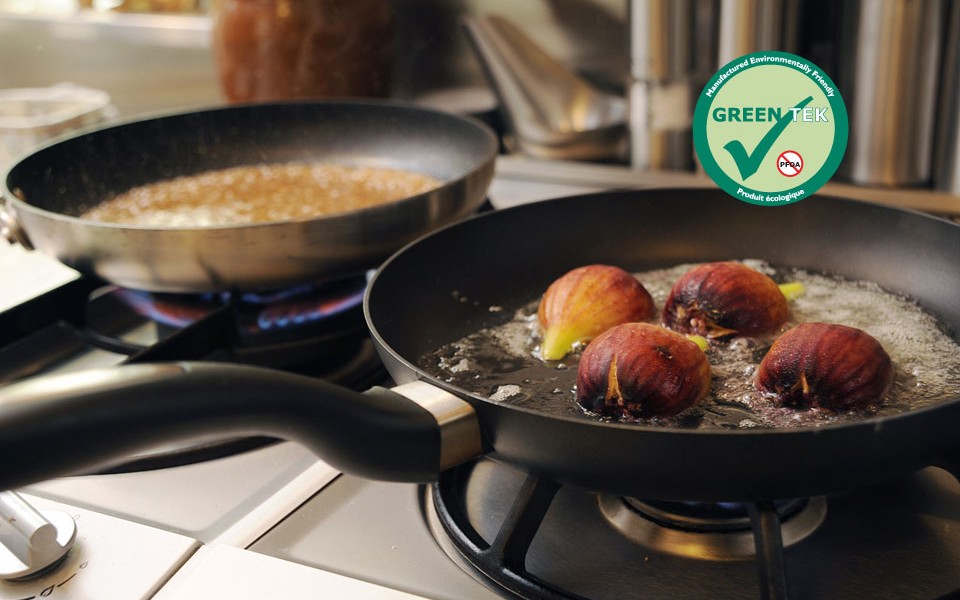Australians young and old are increasingly worried about the safety of non-stick cookware. In all likelihood, you’ve heard rumours that Teflon can cause cancer.
Is there any truth to those rumours? And is there a better type of non-stick pan that you can safely rely on? The answer to both questions is yes. So let’s look a bit at the science of non-stick coatings and what brands like Scanpan are doing to make it safer and more reliable.
The Science Behind Non-Stick Pans and Cancer

There are two main causes of concern for Teflon: PFOA, and overheating. PFOA is a chemical used in the creation of teflon pots and pans (as well as in many other household products). It’s been widely used for decades, but in recent years, there has been speculation among top scientists that it may cause cancer and other health problems.
Now DuPont, the company behind Teflon, points out that PFOA is only used in the process of binding the non-stick coating to pots and pans. They claim that none of the chemical is left over after this binding process. Still, in any case, scientists and governments around the world are working to phase out PFOA.
The good news for consumers is that many non-stick pans made today proudly bear the “PFOA Free” label.
What About Heating Non-Stick Pans?

This is the second major concern and applies to a much wider variety of non-stick pans from all brands. Most consumers simply aren’t aware that their non-stick pots and pans are only designed to operate up to a specific temperature, usually around 250°C. Anything beyond that and problems begin to occur.
As the non-stick coating begins to break down, a cocktail of chemicals is released. But are you at risk when using your pan normally? In the previously mentioned study, the Australian Consumers' Association found that:
“'It's true that chemicals such as trifluoroacetic acid (TFA) can be given off by some coatings at extremely high temperatures. But it's unlikely to happen during normal cooking…Research hasn't indicated harmful long-term effects of TFA on people. At this stage there's no evidence that non-stick cooking poses a safety risk.”
Still, if you’re using your pan on high heat, it’s possible that some hot spots may exceed safe temperatures. To be safe, it’s best to avoid using non-stick cookware for cooking which involves very high temperatures (you should be using stainless steel or cast iron to sear your steaks or brown your chicken). But for the everyday jobs we use our non-stick pans for most frequently, like cooking eggs or sautéing vegetables, it shouldn’t pose any health problems.
What Should Consumers Do?

First, no matter what non-stick pan you’re using, always be aware of that pan’s safe temperature range and stay safely below it. Then, always try to buy PFOA-free cookware. You can always consider something like Le Creuset enamelled cast iron or Lodge cast iron for great cooking performance along with great non-stick surfaces.
Although there are benefits in owning a range of cookware, most Australians have become quite attached to their non-stick pans over the years, so if you’re going to buy one, it makes sense to find one with a stellar record of safety and performance.
Why You Should Consider Scanpan’s GreenTek Coating

However, if you want what the Wall Street Journal called the “Blue Ribbon” of non-stick pans in terms of both safety and performance, consider Scanpan. Its patented GreenTek non-stick surfaces uses a special bonding process the company developed themselves to avoid PFOA entirely.
As the WSJ pointed out, these pans are about as tough as non-stick comes. Their testers really put Scanpan through the paces and found they held up incredibly well. That’s in part due to innovations like silicon rims to avoid scratches and noisy clanging while cooking, as well as an attention to detail in manufacturing the best quality cookware.
Lines like Scanpan Evolution offer traditional non-stick surfaces with added safety and durability. Scanpan Classic, on the other hand, uses a titanium ceramic surface to create a surface so strong that it can handle metal utensils without a scratch (meaning you avoid one of the other major dangers of most non-stick cookware, peeling non-stick layers that can get into your food).

(top image: Scanpan HaptIQ, bottom image: Scanpan TechnIQ)
Scanpan's HaptIQ range places an emphasis on style and design without compromising its functionality, making it perfect for home cooks, whereas
Scanpan's TechnIQ is aimed towards professionals. The TechnIQ range is carefully developed by professional chefs to provide an excellent cooking experience which will in-turn produce exceptional results. Apart from impeccable heat distribution and retention, what makes these ranges great is the new Stratanium+ coating that lines its surface.
Backed by 10 years of research and development, Scanpan's Stratanium+ coating features a marriage of exceptional non-stick characteristics with wear-resistance and unique frying properties. This ultra-enhanced multi-layered coating significantly improves Scanpan's general non-stick properties to offer easy food release, superb hardness, and solid durability.
Invest in Something Healthier
In today’s fast-paced world, consumer health trends and demand for fast cooking and easy cleaning cookware, any way you look at it, non-stick pots and pans are a mainstay of the modern Australian kitchen. With the demand comes great innovations by the major cookware brands like Scanpan who in maintaining their strong reputation have safety as a priority in all of their product development.
Concerned about your “No-name” branded non-stick cookware being safe? If so, it’s probably time to retire your old workhorse and invest in something healthier that will not only have you cooking with peace of mind but will also be able to cope better with your toughest cooking jobs.
Next Read: The Best Non-Stick Pans to Buy in 2020







